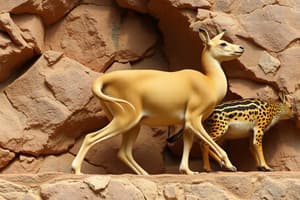Podcast
Questions and Answers
What type of rock is typically formed when magma cools at the mid-ocean ridge?
What type of rock is typically formed when magma cools at the mid-ocean ridge?
- Granite
- Basalt (correct)
- Sedimentary
- Obsidian
At what temperature does magnetite lose its magnetism?
At what temperature does magnetite lose its magnetism?
- 500°C (correct)
- 200°C
- 600°C
- 400°C
What is the phenomena called when magnetite becomes magnetic again upon cooling?
What is the phenomena called when magnetite becomes magnetic again upon cooling?
- Curie conversion
- Thermal magnetization
- Magnetic revival
- Remanent magnetism (correct)
What process describes the large scale motions of Earth's lithosphere?
What process describes the large scale motions of Earth's lithosphere?
Which layer of Earth's interior can flow like a liquid on geological time scales?
Which layer of Earth's interior can flow like a liquid on geological time scales?
Which term describes the process where an old grain is replaced with a new mineral while retaining the relict crystal form?
Which term describes the process where an old grain is replaced with a new mineral while retaining the relict crystal form?
What is the main difference between pseudomorphic and allomorphic replacements?
What is the main difference between pseudomorphic and allomorphic replacements?
What is the term for the physical and biological activities that occur at or near the sediment surface causing mixing of sediment?
What is the term for the physical and biological activities that occur at or near the sediment surface causing mixing of sediment?
Which diagenetic process involves compaction, slumping, and infiltration?
Which diagenetic process involves compaction, slumping, and infiltration?
What type of processes such as cementation, authigenesis, and recrystallization reduce porosity and permeability in sediments?
What type of processes such as cementation, authigenesis, and recrystallization reduce porosity and permeability in sediments?
What process reduces porosity in sedimentary rocks by filling in the pore spaces between grains?
What process reduces porosity in sedimentary rocks by filling in the pore spaces between grains?
Which of the following minerals is NOT mentioned as a common cement in sedimentary rocks?
Which of the following minerals is NOT mentioned as a common cement in sedimentary rocks?
What is the term for the process in which new mineral phases crystallize in sediment or rock during diagenesis?
What is the term for the process in which new mineral phases crystallize in sediment or rock during diagenesis?
In replacement, which type involves the new mineral being the same phase as the old one or a polymorph of it?
In replacement, which type involves the new mineral being the same phase as the old one or a polymorph of it?
What happens to unstable constituents as fluids pass through sediment?
What happens to unstable constituents as fluids pass through sediment?
What term describes the process in which the volume of a sediment is reduced as the grains are squeezed together?
What term describes the process in which the volume of a sediment is reduced as the grains are squeezed together?
Which of the following processes involves inducing a reorientation of the crystal lattices of mineral grains?
Which of the following processes involves inducing a reorientation of the crystal lattices of mineral grains?
Under what conditions does recrystallization in sediment occur?
Under what conditions does recrystallization in sediment occur?
Which diagenetic process involves dissolving a mineral?
Which diagenetic process involves dissolving a mineral?
What factor controls the degree of compaction in sediments?
What factor controls the degree of compaction in sediments?
What is the major diagenetic process that contributes to creating secondary porosity in rocks?
What is the major diagenetic process that contributes to creating secondary porosity in rocks?
Which of the following factors controls the degree to which diagenetic processes contribute to sedimentary rock formation?
Which of the following factors controls the degree to which diagenetic processes contribute to sedimentary rock formation?
Which type of rock is formed from metamorphosis due to intense heat and pressure beneath the Earth's surface?
Which type of rock is formed from metamorphosis due to intense heat and pressure beneath the Earth's surface?
What type of rock is likely to have ribbonlike layers and shiny crystals on its surface?
What type of rock is likely to have ribbonlike layers and shiny crystals on its surface?
Which type of rock is formed when molten rock cools and hardens?
Which type of rock is formed when molten rock cools and hardens?




